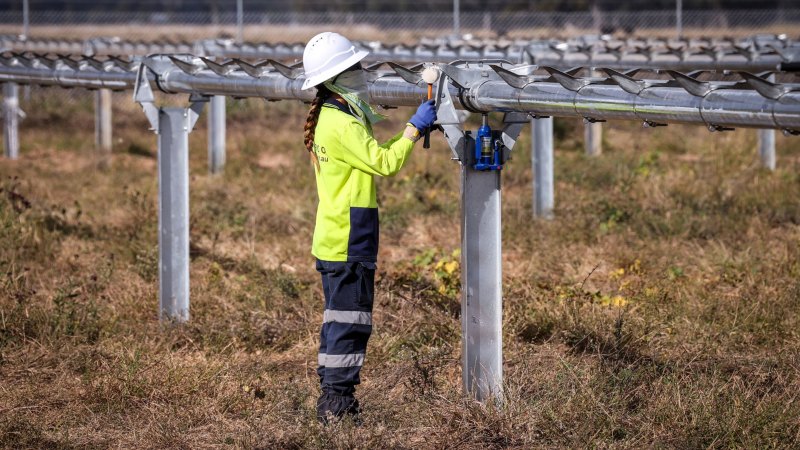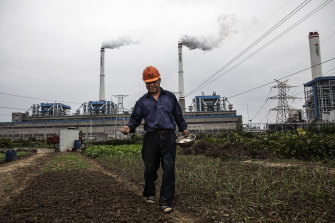Risky strategy for picking winners and losers in the green economy
The Grattan Institute has outlined the daunting challenges facing Australia if it is to be transformed in order to prosper in a net zero global economy and suggested a raft of responses from government to take advantage of the transition. Some of its prescriptions for responding to those challenges will, however, be contentious.
Perhaps the most contentious is its support for government-imposed industry policies, not just to manage the decline in carbon-intensive sectors, but to actively help fund the emergence of the new industries it believes will flourish in what it describes as “the next Industrial Revolution”. It refers to a “strategic partnership” between industry and government.
A worker checks newly constructed metal frames for photovoltaic solar farm. The Grattan Institute advocates government intervention in the green economy.Credit:Bloomberg
The institute isn’t naïve about the reception its advocacy of government intervention might receive from those who would prefer markets to decide the winners in a rapidly changing environment rather than politicians and bureaucrats attempt to pick winners or dictate the losers.
It’s also conscious that wherever governments offer incentives and disincentives there will be rent-seekers. Its response is that the arguments against interventionist industry policies don’t undermine the case for having them but create an imperative for “good” policy which, in this case, it sees as intervention that resembles a portfolio approach – picking a direction and then supporting companies that are willing to transform to carbon-neutral.
“As in any investment portfolio, failure of some bets is expected,” the report said. “The key is to stop supporting the losers.”
That is, frankly, a messy and potentially costly approach for taxpayers and, in electoral terms, potentially the politicians. It would be simpler and less controversial if governments set a clear set of rules (the most obvious, albeit probably politically impossible, would be a price on carbon) and a number of checkpoints in the timeline towards a reduction in carbon emissions, relative to 2005 levels, by 43 per cent by 2030 and net zero by 2050.
A compromise strategy, and one the Albanese government has indicated it will pursue, is to accelerate and broaden the existing “safeguard mechanism” – baseline caps on emissions by the country’s largest emitters – to force emissions reductions and create an economic signal that’s akin to a price on carbon for those companies’ investment decisions.
If this parliament – and it needs to be this parliament, given that the deadlines are rushing towards us – can put the macro framework in place then the incentives for individuals and companies in a market economy will fill in the blanks.
The thesis of Grattan’s report, issued at the weekend, is that there will have to be transformative change to meet global and domestic emissions-reduction targets.
There will be some activities, like coal mining, that it argues will be incompatible with a net-zero economy and industries, such as steel-making, that may have to adopt new low-emission technologies to survive.
More optimistically, there are some critical energy-related minerals – including lithium, cobalt, graphite and clean fuels like hydrogen and ammonia – that Australia doesn’t produce at scale today but which could become enormous opportunities in a net-zero world.
There’s a natural underlying assumption in the report that the world will move to net-zero. China might have committed to net-zero by 2060 but in the meantime it is producing coal at record rates and is adding new coal-fired power stations almost on a weekly basis. Europe is restarting mothballed coal plants and gas fields in the face of a looming energy crisis.
That’s not to suggest that China won’t ultimately make good on its emissions commitments, or that Europe won’t find long-term alternatives to Russian oil and gas, but to illustrate that progress towards lower emissions, globally or domestically, is unlikely to be linear and there will be unexpected disruptions between now and 2050 or 2060. Governments are not good at creating policies that can withstand the unanticipated.
A man tenders to young plants in front of a coal-fired power station in Hanchuan, Hubei province, China.Credit:Getty Images
It is also feasible – there are signs of it already – that as investment in fossil fuel production diminishes prices will rise relative to where they might otherwise have been, prolonging the life of some of the low-cost production Australia exports well beyond current expectations.
It is obvious that however it is managed there will have to be some management of the transition from today’s economy to the one that will emerge as the intermediate deadlines towards net-zero loom.
The new commodities that might become more important and replace the lost economic activity and employment as the role of fossil fuels in the economy is diminished will develop as markets and Australia’s comparative advantages dictate – they shouldn’t need government interventions – but there are regions and industries dependent on coal and gas production that will be severely impacted.
One of Grattan’s suggestions is that state governments use the windfalls from the high prices for energy currently being experienced and the anticipated boom in critical minerals to create future funds to help the impacted communities and share the windfall benefits with future generations.
It’s not advocating a windfall profits tax (although it does tentatively raise the prospect of a windfall profits tax on the record coal and gas profits now being generated) but rather the diversion of the additional royalties the governments will collect.
There’s a lot more detail in its recommendations. It wants a more strategic approach to capital grants programs and other funds targeting clean energy than the current approach, under which it says funds are allocated more with an eye to buying votes than building economic prosperity.
At its core, however, the report is advocating highly interventionist policies that will end up with governments picking winners and deciding losers, at least as far as taxpayer funds are concerned.
It is necessary that the current suite of ad hoc policy measures and existing interventions – some of which support fossil fuel production and consumption – should be reviewed and a broad strategy of achieving net-zero while responding to the inevitable convulsions, particularly the impact on regional communities, that will occur within today’s economy be developed.
It would be preferable, however, if taxpayer funds were preserved to help the losers from this abrupt shift toward a very different economy while allowing the markets and the risk-takers to sort out the new economy’s winners and losers.
The Business Briefing newsletter delivers major stories, exclusive coverage and expert opinion. Sign up to get it every weekday morning.
Most Viewed in Business
From our partners
Source: Read Full Article



